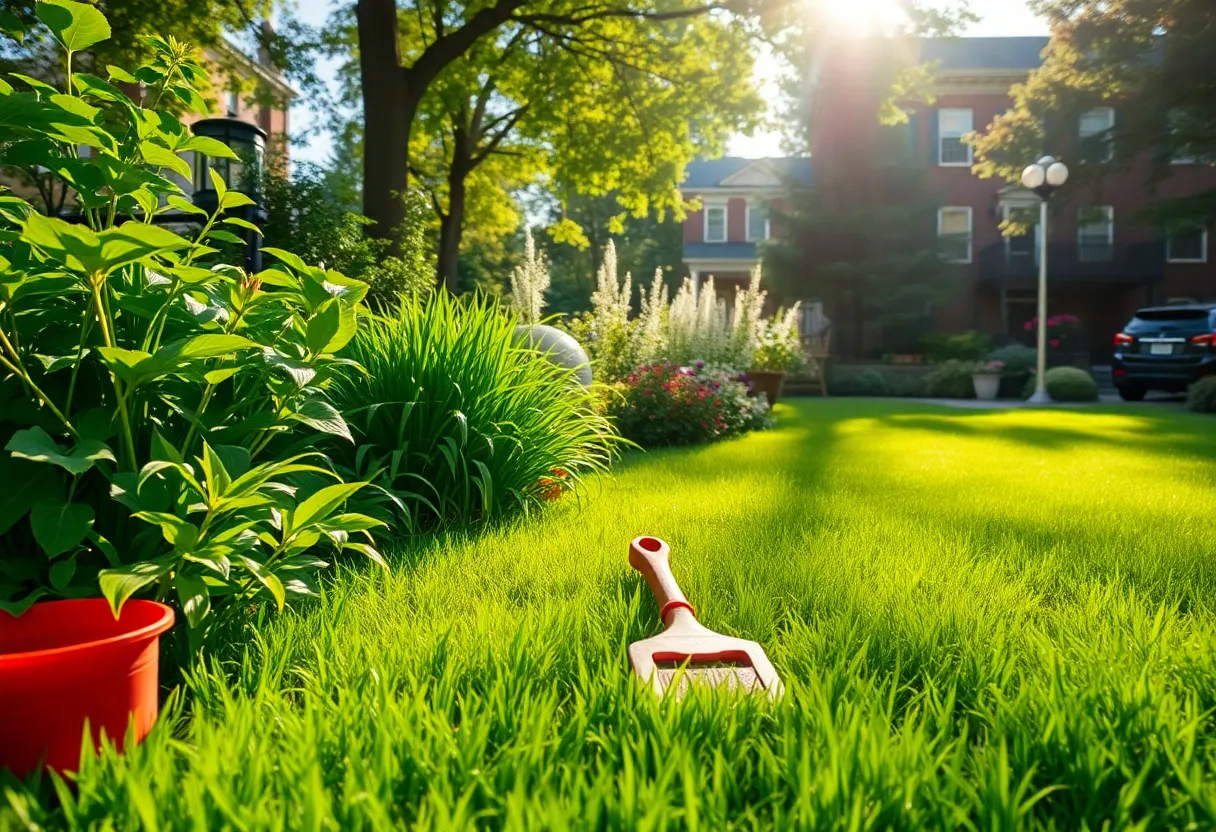Revitalizing Your Philadelphia Lawn: A Strategic Approach to Regional Climate and Soil Conditions
Transforming a tired, patchy lawn into a lush, vibrant green space requires more than generic care routines. Philadelphia’s unique climate and soil conditions demand tailored strategies that address specific regional challenges. By understanding these factors and implementing targeted practices, you can enhance your property’s aesthetic appeal with a healthy, sustainable lawn.
Understanding Philadelphia’s Climate and Soil
Regional Climate Characteristics
Philadelphia experiences a humid subtropical climate, characterized by hot, humid summers and cold, damp winters. Summers can bring temperatures exceeding 85°F, coupled with high humidity levels, fostering fungal growth and other turf diseases. Winters often see snow and freezing temperatures, which can cause stress or dormancy in many grass types.
This climate influences what grass varieties thrive and how often certain maintenance routines should be performed. Adapted care practices are essential for resilient lawns that withstand seasonal fluctuations.
Soil Composition and Challenges
The region’s soil typically leans toward acidic pH levels, often between 5.0 and 6.0. This acidity impacts nutrient availability, especially nutrients like calcium, magnesium, and potassium. Additionally, the soil may be compacted or heavy in clay, impairing drainage and root development.
Understanding soil properties informs whether amendments are necessary to optimize growing conditions. Testing soil is a crucial first step to determine pH and nutrient deficiencies accurately.
Essential Lawn Care Practices for Philadelphia
Soil Testing and pH Adjustment
Soil testing provides critical data on pH, nutrient levels, and soil texture. Conduct tests every 2-3 years to guide amendments. If tests reveal acidic soil, applying lime can neutralize the pH, improving nutrient uptake and promoting healthy growth.
Choosing the right lime type and application rate is essential. Over-liming can shift pH too far toward alkalinity, creating new issues. Regular testing ensures balance and optimal conditions.
Aeration
Aeration alleviates soil compaction, particularly in lawns with heavy foot traffic or clay dominance. Creating small holes improves air exchange, water infiltration, and nutrient access to the roots.
In Philadelphia, perform aeration in early fall—ideally September or October—when temperatures are moderate, and the grass is still actively growing. This timing promotes lawn recovery and prepares it for overseeding and fertilization.
Overseeding
Introducing new grass seed rejuvenates thin or bare patches, enhances lawn density, and increases disease resistance. The best window for overseeding in Philadelphia spans late September through mid-October, aligning with favorable soil warming and cooler weather.
Use regionally-adapted seed blends that tolerate the local humidity and soil acidity. Overseeding in these months ensures seed establishment before winter dormancy.
Fertilization
Proper fertilization replenishes nutrients essential for vigorous growth. In Philadelphia, scheduled applications in early spring and late fall align with active growth periods.
Opt for slow-release fertilizers to provide a steady nutrient supply, minimize runoff, and support environmental sustainability. Over-application can lead to pollution and weak plant growth.
Mowing
Maintain mower blades sharp for clean cuts. Keep grass height at approximately 3 inches; this promotes deeper roots, shade, and weed suppression.
Adjust mowing frequency based on growth rates. During peak season, mowing weekly is ideal. Avoid cutting more than one-third of the grass height at a time to reduce stress.
Watering
Deep, infrequent watering—approximately 1 inch weekly—strengthens roots and reduces disease risk. Early morning watering minimizes evaporation and fungal issues.
Monitor rainfall and adjust irrigation accordingly. Overwatering can lead to shallow roots and increased susceptibility to pests and disease; under-watering causes stress and poor growth.
Weed and Pest Control
Consistent lawn monitoring is vital. Implement pre-emergent herbicides in early spring to prevent weed seeds from sprouting. For existing weeds, use targeted post-emergent treatments or manual removal.
Address pest issues promptly; common pests include grubs, chinch bugs, and fungal infections. Use integrated pest management strategies that minimize chemical use.
Thatch Management
Thatch is a layer of dead grass material accumulating between the soil and green vegetation. Excessive thatch—over half an inch—interferes with water and nutrient absorption.
Dethatching in early fall allows for better soil contact and recovery. Use dethatching tools carefully to avoid damaging the turf.
Seasonal Lawn Care Adjustments
Adapting routines to seasons ensures optimal results:
- Spring: Clean debris, aerate, overseed, and fertilize to prepare for the active growing season.
- Summer: Maintain watering, mow regularly, and monitor for pests and disease. Raise mowing height during hot months to reduce stress.
- Fall: Focus on aeration, overseeding, fall fertilization, and reducing mowing frequency. Prepare for winter dormancy.
- Winter: Minimize foot traffic and avoid fertilization. Protect turf from ice damage if applicable.
Sustainable Lawn Care Practices
Environmental responsibility enhances your lawn’s resilience and reduces pollution. Implement strategies such as using organic fertilizers, avoiding excessive chemical applications, and planting native vegetation.
Sustainable practices promote biodiversity, improve soil health, and lessen runoff into local waterways. They also contribute to a healthier ecosystem in your neighborhood.
Conclusion
Revitalizing a Philadelphia lawn requires a strategic combination of soil management, climate-adapted practices, and sustainability. Understanding the region’s climate and soil complexities enables precise interventions that foster a lush, durable turf.
By adhering to region-specific care routines—such as timely aeration, overseeding, and pH adjustments—you will achieve a vibrant, resilient lawn that elevates your outdoor space’s aesthetic and functional appeal.
FAQs
How often should I test my Philadelphia lawn’s soil?
Soil testing should be conducted every 2 to 3 years to monitor pH levels and nutrient status. This frequency ensures timely amendments and optimal growing conditions.
What is the best time to aerate my Philadelphia lawn?
Aeration is best performed in early fall, specifically September or October, when temperatures are moderate and grass recovery is optimal.
How can I improve soil acidity issues in my lawn?
If soil tests show high acidity, applying lime can neutralize pH levels. Proper application based on test recommendations prevents pH from shifting too far toward alkalinity.
How do I choose the right grass seed for Philadelphia’s climate?
Select regionally-adapted seed blends that tolerate humidity, temperature fluctuations, and soil acidity. Cool-season grasses like Kentucky bluegrass, fescue, or perennial ryegrass often perform well.
Key Features of Philadelphia Lawn Care
| Aspect | Region-Specific Strategy | Timing | Core Benefit |
|---|---|---|---|
| Soil pH Adjustment | Apply lime based on soil test results to neutralize acidity | Every 2-3 years, early fall | Enhanced nutrient absorption and healthier grass |
| Aeration | Perform in early fall to reduce compaction | September-October | Improved air, water, and nutrient access to roots |
| Overseeding | Use regionally adapted seed blends during late September to mid-October | Fall period | Thicker, more resilient lawn density |
| Fertilization | Use slow-release fertilizers during spring and fall | Early spring & late fall | Steady nutrient supply for vigorous growth |
| Watering | Deep and infrequent, early morning | Throughout growing season | Deep roots and drought resilience |
Author: STAFF HERE PHILADELPHIA WRITER
The PHILADELPHIA STAFF WRITER represents the experienced team at HEREPhiladelphia.com, your go-to source for actionable local news and information in Philadelphia, Philadelphia County, and beyond. Specializing in "news you can use," we cover essential topics like product reviews for personal and business needs, local business directories, politics, real estate trends, neighborhood insights, and state news affecting the area—with deep expertise drawn from years of dedicated reporting and strong community input, including local press releases and business updates. We deliver top reporting on high-value events such as Mummers Parade, Philadelphia Flower Show, and Thanksgiving Day Parade. Our coverage extends to key organizations like the Greater Philadelphia Chamber of Commerce and United Way of Greater Philadelphia, plus leading businesses in telecommunications, food services, and healthcare that power the local economy such as Comcast, Aramark, and Children's Hospital of Philadelphia. As part of the broader HERE network, we provide comprehensive, credible insights into Pennsylvania's dynamic landscape.





